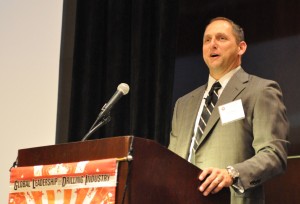Emerging plays spark growth in onshore drilling

By Katherine Scott, editorial coordinator
A panel session of three speakers from Statoil, Marathon Oil and Devon Energy Corp discussed activities and trends in US shale plays where they are operating at the 2012 IADC Drilling Onshore Conference and Exhibition on 17 May in Houston. These companies are looking increasingly to oil, new-technology rigs and better seismics to enhance performance in plays such as the Bakken, Eagle Ford, Permian Basin and Barnett.
Statoil
Statoil has active North American onshore assets in the Marcellus, Eagle Ford and Bakken. In the first two, the company is working in joint development with Chesapeake Energy and Talisman Energy. The Bakken assets, which came with the acquisition of Brigham Exploration in December 2011, account for an operating area of approximately 375,000 acres and a resource potential of 300 to 500 million boe, said Erik Hoover, operations manager for Statoil.

Starting with one rig in August 2009, Statoil has steadily increased its activity in the Bakken over the past three years, reaching a maximum of 19 rigs in April 2012. “Our forecast is to go to 16 rigs for the next year,” Mr Hoover said.
The company began in the Bakken three years ago with ”40-year-old mechanical rigs” but has begun to modernize its fleet. “We’re slowly pulling mechanicals out of the fleet and upgrading them with available electric rigs, while at the same time ordering new-technology, AC rigs.”
“Our goal, and I think it will reach that, is by the end of the first quarter of next year, 13 of our 16 rigs will be new-technology rigs,” he continued.
Statoil also is bringing bi-fuel rigs to the Bakken to take advantage of the excess gas available in the area. “All of our new rigs that we’re building right now all have bi-fuel systems, which will allow us to run a combination of natural gas and diesel, or 100% diesel if we don’t have natural gas available,” Mr Hoover explained.
Marathon Oil

Marathon has boosted its onshore US activity focus within the past couple of years, and almost all of it is geared toward oil. Only one of Marathon’s approximately 40 running rigs is focused on gas, located in Alaska. “Everything else we’re doing is oil-focused… I think that’s going to be a consistent trend in North America for some time to come,” said Lance Robertson, regional vice president for Marathon Oil.
Over the next five years, the company expects to see 125,000 bbl/day of production growth just from the Bakken, Niobrara, Woodford and Eagle Ford plays. “That’s a lot of activity. We’re going to drill a lot of wells on those million-plus acres.”
Among those plays, the Eagle Ford is still a relatively new area for the company. Since its first significant acquisition in November, the company has increased its rig count from two to 18 over a five-month period. Currently, the company is producing over 20,000 bbl/day and expects to exit the year with an average of 30,000 bbl/day, drilling more than 220 wells in 2012. “The Eagle Ford is one of those basins where everything learned in the Bakken, everything learned in Haynesville and a lot of other places have come to some fruition very quickly,” said Lance Robertson, regional vice president for Marathon Oil.
The rapid growth in the Eagle Ford was also supported by a decision to place a focus on values and involvement with people they trust and respect, Mr Robertson said. This, in turn, led to greater efficiency, he believes.
The growth also has been supported by a focus on the full spud-to-spud cycle rather than spud-to-TD – something Mr Robertson encouraged other companies to do as well. “We just finished April at right over 20 days spud to spud, averaging 17,800 ft, so we’ve come almost 50% faster in the first six months.”
Devon Energy Corp
David Fortenberry, drilling manager for the central division of Devon Energy Corp, said that his company is operating 69 rigs across a range of North American assets in plays like the Barnett, Permian Basin, Mississippian, Ohio Utica and Tuscaloosa and in the Canadian oil sands.

Within its 1.5 million acres in the Permian Basin, Devon has 21 rigs running and is heading toward 24. “It will probably be in the 40-rig range in two years from now, so it’s a great growth area for us,” Mr Fortenberry said. He also continues to see more pad drilling, longer laterals and multi-well pads in the Permian, where he said Devon recently landed its first lateral well at approximately 7,200 ft.
On the eastern part of the Permian Basin, the company operates in the Cline Shale. Mr Fortenberry believes that while the need for 3D seismic in this 500,000-acre mature basin may not be apparent, “it’s for really getting in there and characterizing the rock and tying it to production and really understanding what you’re dealing with.”
Another mature basin that Devon Energy operates in is the Barnett. The company has 10 rigs there now but may drop it to nine moving toward, and plans to drill 300 wells there in 2012 with increased focus on expansion areas.
The key there is identifying the sweet spot, Mr Fortenberry said. Devon Energy continues to experiment things such as seismic, identifying gas from liquids and picking landing points. “We’re learning more and more about what makes the rock work and what makes it not work.”




